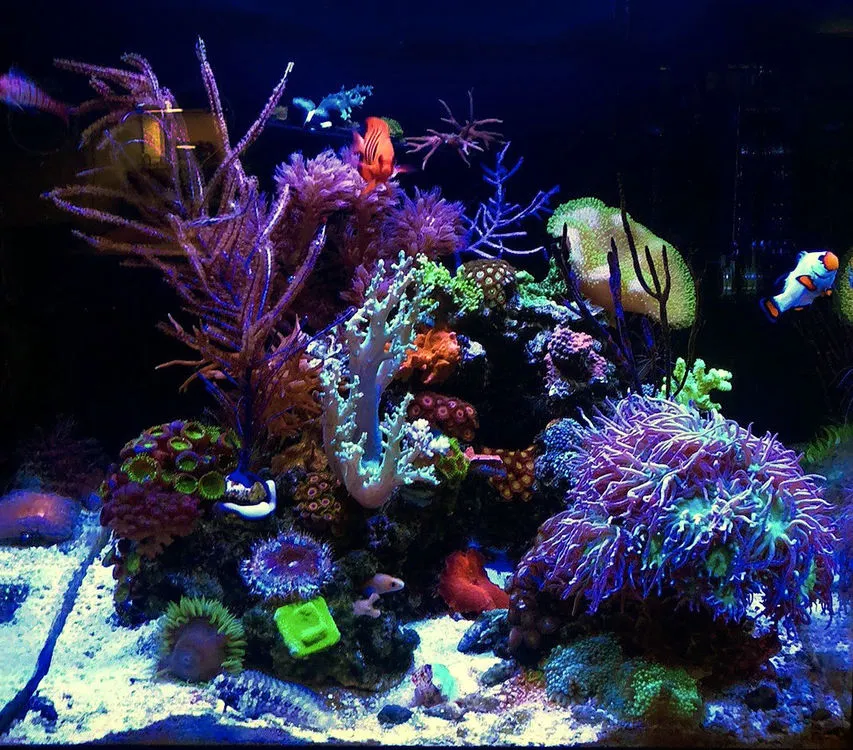Stunning 28-Gallon Reef Tank – William's TOTM | NanoReef

Tank Specifications
Volume: 28 Gallons / 106 Liters
Dimensions (L × W × H):
18.0" ×
18.0" ×
18.0"
45.7cm ×
45.7cm ×
45.7cm
Equipment List
- Salt: Brightwell
Frequently Asked Questions
How should I set up my nano reef tank for optimal growth?
To set up your nano reef tank for optimal growth, consider using a robust filtration system, a quality protein skimmer, and a reliable circulation system. For instance, in William's setup, he uses a Waveline DC2500 for return, an AquaMaxx WS-1 skimmer, and two MP10 wES circulation pumps running at 70% power. These components create excellent water quality and circulation for your corals and fish.
What is the ideal lighting setup for a nano reef tank?
The ideal lighting for a nano reef tank typically depends on the types of corals you wish to keep. Using a light like the Nanobox Duo Plus set on SSP preset, as seen in William's tank, can help provide the diverse spectrum needed for various coral types.
How can I maintain stable water parameters in a reef tank?
To maintain stable water parameters, it's crucial to regularly test your water and monitor parameters such as salinity, alkalinity, calcium, and nitrates. Using a controller like the Apex Lite can help automate water testing and maintenance routines. Additionally, consistent water changes, like William’s monthly 25% changes, contribute significantly to stability.
What type of water do I need for my reef tank?
Using a high-quality salt mix, such as Brightwell Aquatics NeoMarine, combined with RO/DI water, is essential for a reef tank. This assures that you are starting with pure water free of contaminants.
How do I manage algae growth in my reef tank?
Managing algae growth can be achieved through various strategies such as maintaining nutrient levels, increasing water flow, and introducing competent cleanup crew members like emerald crabs and snails. In William’s experience, adding more emerald crabs significantly helped control algae.
What will my weekly maintenance schedule look like?
A suggested weekly maintenance routine includes cleaning the glass with a magnet cleaner, changing filter floss, and refilling the top-off reservoir. William performs these tasks regularly to keep his tank clean and the water parameters steady.
How often should I feed the fish in a reef tank?
Fish in a reef tank should typically be fed once or twice daily. In this case, William feeds his fish two times a day using an auto-feeder, which helps maintain consistent feeding times and nutrient levels.
What is the proper way to conduct a water change in a reef tank?
To conduct a water change, prepare the new water first with the correct salinity and temperature. Using a siphon, remove approximately 25% of the tank water, vacuuming the substrate if necessary. Replace it with the pre-mixed fresh saltwater, ensuring that you've tested parameters ahead of time.
How should I manage dosing nutrients in my reef tank?
Managing dosing involves understanding the specific needs of your corals and adjusting based on your water test results. William uses a Jebao DP-4 doser for two-part solutions for calcium and alkalinity, along with daily doses of Acropower for amino acids, ensuring his corals receive adequate nutrients.
What is the best way to feed corals?
Corals can be fed via suspended foods or target feeding. In his tank, William doses Lugol’s Solution weekly through his top-off water and occasionally supplements with Microbacter 7. It's essential to observe and adjust based on the response of your corals.
How do I select compatible fish for a mixed reef tank?
When selecting fish for a mixed reef tank, aim for species that occupy different niches and exhibit compatible behaviors. William’s selection, including a Golden Dwarf Moray Eel and various colorful reef fish, creates visual interest while maintaining peace within the tank.
How can I introduce new corals into my reef tank?
To introduce new corals, acclimate them carefully to the tank environment by floating them in the tank for about 15-30 minutes before placing them in their desired location. Monitor their health closely for signs of stress or coral bleaching post-introduction.
What should I do if I experience coral bleaching in my tank?
If you notice coral bleaching, it may indicate stress often related to fluctuations in water parameters, lighting, or flow. Check all parameters and make the necessary adjustments, slowly reintroducing light or altering flow. Regular monitoring can prevent further stress and help coral recovery.